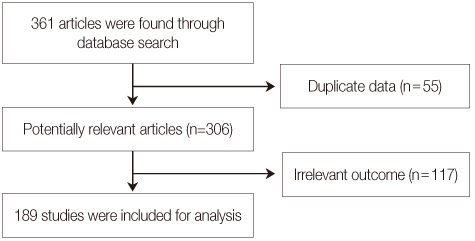J Korean Acad Nurs.
2013 Dec;43(6):697-703. 10.4040/jkan.2013.43.6.697.
Validity of Instrument Development Research in Korean Nursing Research
- Affiliations
-
- 1Division of Nursing Science, College of Health Science, Ewha Woman's University, Seoul, Korea.
- 2Department of Nursing, College of Medicine, Soonchunhyang University, Cheonan, Korea. ssj1119@sch.ac.kr
- KMID: 1711261
- DOI: http://doi.org/10.4040/jkan.2013.43.6.697
Abstract
- PURPOSE
This integrative review study was done to analyze methods used for validation studies in Korean nursing research.
METHODS
In this study, the literature on instrument development in nursing research from Research Information Sharing Service (RISS) and major nursing journal databases in Korea were examined. The MeSH search terms included 'nursing', 'instrument', 'instrument development', 'validation' and 189 articles were included in the review.
RESULTS
The most frequently reported validity type was content validity, followed by construct validity, and criterion validity. One third reported a single type of validity, and 15% of the studies demonstrated three kinds of validity at the same time. In about 40% of the studies, both content and construct validity were examined.
CONCLUSION
The results of the study indicate that it is necessary to provide a wider variety of evidence to establish whether instruments are valid enough to use in nursing research.
Keyword
Figure
Cited by 3 articles
-
Development of Pregnancy Risk Symptom Perception Scale
Mi Heyi Kim, So Young Choi
Korean J Women Health Nurs. 2018;24(3):297-309. doi: 10.4069/kjwhn.2018.24.3.297.Validity and Reliability of the Korean Version Scale of the Clinical Learning Environment, Supervision and Nurse Teacher Evaluation Scale (CLES+T)
Sun-Hee Kim, So Yeon Yoo, Yae Young Kim
J Korean Acad Nurs. 2018;48(1):70-84. doi: 10.4040/jkan.2018.48.1.70.Reliability and Validity of Korean Version of Nursing Students’ Anxiety and Self-Confidence with Clinical Decision Making Scale
Mi Yu, Young Eun, KA White, KyungJa Kang
J Korean Acad Nurs. 2019;49(4):411-422. doi: 10.4040/jkan.2019.49.4.411.
Reference
-
1. American Educational Research Association [AERA]. American Psychological Association [APA]. National Council on Measurement in Education [NCME]. The standards for educational and psychological testing. Washington, DC: AERA Publications;1999.2. Campbell DT, Fiske DW. Convergent and discriminant validation by the multitrait-multimethod matrix. Psychol Bull. 1959; 56(2):81–105. http://dx.doi.org/10.1037/h0046016.3. Carnevale T. An integrative review of adolescent depression screening instruments: Applicability for use by school nurses. J Child Adolesc Psychiatr Nurs. 2011; 24(1):51–57. http://dx.doi.org/10.1111/j.1744-6171.2010.00256.x.4. Choi SH, Lee EJ, Park MJ, Kim HS, Kim MH, Choi JY. Nursing outcomes measurement indicators. Gwangju: Chonnam National University Press;2012.5. Choi SJ, Bae SY, Choi JY, Bang HJ. Development and predictive validity of pressure ulcer predicting scale for patients with neurologic condition. Clin Nurs Res. 2006; 11(1):95–108.6. Cronbach LJ, Meehl PE. Construct validity in psychological tests. Psychol Bull. 1955; 52(4):281–302.7. DeVellis RF. Scale development: Theory and applications. 2nd ed. Thousand Oaks, CA: Sage Publications, Inc;2003.8. DeVellis RF. Scale development: Theory and applications. 3rd ed. Newbury Park, CA: Sage Publications, Inc;2011.9. Foster RL, Park JH. An integrative review of literature examining psychometric properties of instruments measuring anxiety or fear in hospitalized children. Pain Manag Nurs. 2012; 13(2):94–106. http://dx.doi.org/10.1016/j.pmn.2011.06.006.10. Gronlund NE, Linn RL. Measurement and evaluation in teaching. 6th ed. New York, NY: Macmillan Publishing Company;1990.11. Hopfenbecka TN, Maul A. Examining evidence for the validity of PISA learning strategy scales based on student response processes. Int J Test. 2011; 11(2):95–121. http://dx.doi.org/10.1080/15305058.2010.529977.12. Ju HO, Lee NY, Park IS, Lee SO, Kim SH. Development & validation of a checklist for infant and child developmental screening. J Korean Acad Child Health Nurs. 2009; 15(1):34–41. http://dx.doi.org/10.4094/jkachn.2009.15.1.34.13. Kane MT. Current concerns in validity theory. J Educ Meas. 2000; 38(4):319–342. http://dx.doi.org/10.1111/j.1745-3984.2001.tb01130.x.14. Kang H. A guide on the use of factor analysis in the assessment ofconstruct validity. J Korean Acad Nurs. 2013; 43(5):587–594. http://dx.doi.org/10.4040/jkan.2013.43.5.587.15. Kim KN, Kim CH, Kim KI, Yoo HJ, Park SY, Park YH. Development and validation of the Korean nursing delirium scale. J Korean Acad Nurs. 2012; 42(3):414–423. http://dx.doi.org/10.4040/jkan.2012.42.3.414.16. Lee EO, Im NY, Park HA, Lee IS, Kim JI, Bae J, et al. Nursing research and statistical analysis. 4th ed. Paju: Soomoonsa;2009.17. Lee I, Park YI, Park E, Lee SH, Jeong IS. Validation of instruments to classify the frailty of the elderly in community. J Korean Acad Community Health Nurs. 2011; 22(3):302–314.18. Lee W. Unified view on validity. J Educ Eval. 2008; 21(4):67–79.19. Park HA. Problem and issues in developing measurement scales in nursing. Korean J Nurs Query. 2005; 14(1):46–72.20. Pett MA, Lackey NR, Sullivan JJ. Making sense of factor analysis: The use of factor analysis for instrument development in health care research. Thousand Oaks, CA: Sage Publications, Inc;2003.21. Ribeiro MAS, Vedovato TG, de Moraes Lopes MHB, Monteiro MI, de Brito Guirardello E. Validation studies in nursing: Integrative review. Rev Rene. 2013; 14(1):218–228.22. Seong TJ. Validity and reliability. Seoul: Hakjisa Publisher;2002.23. Shin H, Kim J, Lim S. A study to validate the Korean child development review. J Korean Acad Child Health Nurs. 2007; 13(2):222–229.24. Shin H, Kwon B, Lim S. Validity of Korean version of denver II in screening children with developmental risk. Korean J Child Health Nurs. 2005; 11(3):316–321.25. So AY, Cho BH. Development of a home care need assessment tool: Focused on home care nursing diagnoses based on self care. J Korean Acad Community Health Nurs. 2002; 13(3):433–443.26. Waltz CF, Strickland OL, Lenz ER. Measurement in nursing and health research. 4th ed. New York, NY: Springer Publishing Company;2010.
- Full Text Links
- Actions
-
Cited
- CITED
-
- Close
- Share
- Similar articles
-
- Development of an Instrument to Assess the Nursing Professional Pride
- Development of an Evaluation Instrument for Service Quality in Nursing Homes
- A Study on the Reliability and Validity of the Korean Version of Self-directed Learning Instrument
- Psychometric properties of an instrument 3: convergent, discriminant, known-groups, and criterion validity
- Development and Validity of Workplace Bullying in Nursing-Type Inventory (WPBN-TI)



